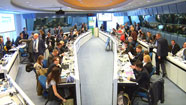On 5 April 2016 the JRC presented the interactive and collaborative online European Energy Efficiency Platform. This beta platform is conceived to fill the gap opened by scattered data and fragmented knowledge resulting from a rapidly growing energy efficiency market. It is expected to be both a one-stop shop for information retrieval and a meeting point for experts to exchange data and reduce redundant activities.
Deep renovation and nZEB data collection
Refurbished nZEBs and deep retrofit data collection - Harmonisation of criteria for a comparative analysis and information exchange on measures implemented to achieve the objective of the Energy Performance of Buildings Directive (EPBD) on existing buildings.
A database of nZEB and deep retrofit buildings
The EC-DG Joint Research Centre is creating an international database of nZEB and deep retrofit buildings through a data collection which will allow comparison across MSs.
This harmonised data collection will become the basis of a common picture of the EU state of the art in implementing the Energy Perfomance of Buildings Directive in the existing buildings.
Follow the link to the data collection.
Deep Renovation and nZEB Data Collection Form
Nearly Zero Energy Buildings and the Energy Performance in Buildings Directive
 With the entry into force of the EPBD, Member States were required to draw up National Plans for increasing the number of nearly Zero Energy Buildings.
With the entry into force of the EPBD, Member States were required to draw up National Plans for increasing the number of nearly Zero Energy Buildings.
According to paragraph 3 of Article 9 of the EPBD, these plans shall include nZEB definitions reflecting national, regional or local conditions, and a numerical indicator of primary energy use.
Articles 6 and 7 of the EPBD recast, and Article 13(4) of the Renewable Energy Directive (RED), state that MSs have to give information on policies, financial or other measures adopted for the promotion of nZEBs, including details on the use of renewable energy sources in new buildings and in existing buildings undergoing major renovation.The implementation of nZEBs as the building target from 2018 onwards represents one of the biggest challenges to increase energy savings and minimize greenhouse gas emissions in buildings.
Energy requirements
The European Commission does not provide minimum or maximum harmonized requirements, neither details of energy performance calculation. It is up to MS to define what “a very high energy performance” and “to a very significant extent by energy from renewable sources” constitute for them. In particular, climate conditions have a relevant influence on construction technologies and on energy needs that characterize a building.
As expected, on one hand this allows to adapt the general principles to the specific characteristics of national contexts, on the other this has implied not fully comparable results.
Implementation of the nZEB target
The development and implementation of suitable instruments and measures to reach the nZEB target is uneven among European countries.According to a JRC analysis, few MSs have provided a definition that comprises both a numerical target (between 0 and 220 kWh/m2/y) and a specific share of renewables.
Different approaches have been followed. Many countries have chosen minimum energy performance requirements or a required energy performance certificate level. Other MSs have defined qualitative targets.
Intermediate targets for the refurbishment of existing buildings have been set by some MSs while either have established intermediate targets for public buildings.
Reference Buildings
The existing residential building stock, to which an average age of about 55 years is attributed, is the main challenge that MSs are facing an economic downturn.
There is a great unrealised potential for energy saving in the refurbishment sector, to which other key benefits are related: improvement in energy security, job creation, fuel poverty alleviation, improved indoor comfort, increased property values, energy system benefits, etc.
Member States are also required to define reference buildings that represent the typical and average building stock in each country, in order to obtain general results consistent with the characteristics of the analysed building stock.
Reference buildings can differ within MSs, because each country follows quiet different approaches in the definition of the typologies and of the degrees of detail; as a result information about buildings is often dissimilar; but it represents the basis for studies assessing the achievements in terms of energy performance imcrease and energy saving possibilities also in nZEB refurbished buildings.




To quote this article use the follonwing format: